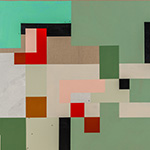The exhibition Cipher at Gazelli Art House London presents the work of two female painters with roots in the Persian Gulf and the Middle East, Pouran Jinchi (b.1959, Mashhad, Iran) and Ruba Salameh (b.1985, Nazareth).
The artists come from different generations, but share an innovative and emotionally affecting use of abstraction and pattern. Their paintings are deeply connected to the traditions of Islamic calligraphy and geometric design, while also in dialogue with multiple moments and styles from across the Western modernist and post-modernist canon.
The exhibition title Cipher points to the shared interest of Jinchi and Salameh in abstract painting operating as a coded system of communication – a language simultaneously impacting the senses and operating as an enigmatic puzzle of sorts. Additionally, the etymology of the word highlights a significant historical moment of scientific and cultural influence and exchange. Originating from the Arabic word for zero (sifr), the term ‘cipher’ spread to Europe as part of the Arabic numeral system during the Middle Ages, where it crucially supplemented the Roman numerical system which lacked the concept of zero, which today is used across the globe and is a key building block of the digital world. Tracing the lines of connection back further still, in the last decade there has been the discovery of the earliest recorded use of a symbol for zero in the Bakhshali manuscript, an ancient Indian scroll dating back to the third or fourth century.
Pouran Jinchi’s works in the exhibition bear testament to her ongoing exploration of how architecture, objects, decoration, and the written word can be imbued with symbolic power. Trained as a mathematician and classical calligrapher in Iran, Jinchi went on to study art in Los Angeles and New York. A constant across her decades of work is the way she explores a productive tension between the seeming control of Islamic calligraphy and the fluid spontaneity associated with Western abstract painting.
In this exhibition, Jinchi presents a group of works in which she quietly observes the unspoken traces of war, conflict, and militarism embedded within language and culture. Reflecting on specific examples, such as phonetic alphabets, military insignia, medals, war paint, and camouflage, Jinchi used wood and enamel to produce individual tiles. She created sculptural paintings marked with finely calibrated brush strokes painting fragmented Persian letters corresponding to the military’s phonetic alphabet—B is for Bravo, P is for Papa, Z is for Zulu. Colour plays a crucial role across all of Jinchi’s work, and in this series, the tones came from battleground camouflage, the stripes of military ribbons, and the coded shades of naval flags. The resulting pieces feel emblematic, striking, and playful like children’s games.
Palestinian painter Ruba Salameh presents a series of paintings in which blocks and lines of concrete greys and pale hues evoke aerial views of a city or electronic circuit boards. This visual language draws on Constructivism, Bauhaus, Minimalism, and even the 1980s Neo-Geo work of American painters such as Peter Halley (b.1953). Yet notions of balance, harmony and firm geometry are disrupted by Salameh. The shapes on her canvases are far from regular and constantly shift and jostle in front of the eye. On the surface of the pictures can be seen small black dots, which on close inspection are revealed as depictions of ants. Some gather around shapes as if to carry them away, others seem to be stuck in corners or forced along paths. The addition of the ants to the pictures suggests a meeting of the man-made and organic, the disruption of a pure surface, and alludes to the resilience of communities suffering oppression.
Through their dynamic recalibration of the many strands that exist within the history of abstract painting, Jinchi and Salameh subvert fixed readings of place and nationality. Their works celebrate hybridity and lines of global connection, while allowing insight into the specific qualities of time, place and lived experience.
Press release from Gazelli Art House
Image: Ruba Salameh. Carmel. 2021. Acrylic on linen. 128 × 183 cm. Image courtesy of the artist and Gazelli Art House



